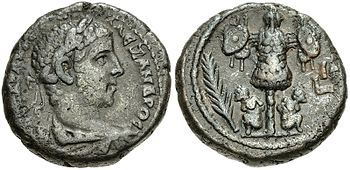233
Portal Geschichte | Portal Biografien | Aktuelle Ereignisse | Jahreskalender | Tagesartikel
◄ | 2. Jahrhundert | 3. Jahrhundert | 4. Jahrhundert | ►
◄ | 200er | 210er | 220er | 230er | 240er | 250er | 260er | ►
◄◄ | ◄ | 229 | 230 | 231 | 232 | 233 | 234 | 235 | 236 | 237 | ► | ►►
| 233 | |
|---|---|
(c) Classical Numismatic Group, Inc. http://www.cngcoins.com, CC BY-SA 2.5 beendet den Feldzug gegen das Perserreich mit einem Triumphzug. | |
| 233 in anderen Kalendern | |
| Äthiopischer Kalender | 225/226 |
| Buddhistische Zeitrechnung | 776/777 (südlicher Buddhismus); 775/776 (Alternativberechnung nach Buddhas Parinirvana) |
| Chinesischer Kalender | 48. (49.) Zyklus, Jahr des Wasser-Büffels 癸丑 (am Beginn des Jahres Wasser-Ratte 壬子) |
| Griechische Zeitrechnung | 4. Jahr der 252. / 1. Jahr der 253. Olympiade |
| Jüdischer Kalender | 3993/94 (20./21. September) |
| Römischer Kalender | ab urbe condita CMLXXXVI (986) |
| Seleukidische Ära | Babylon: 543/544 (Jahreswechsel April); Syrien: 544/545 (Jahreswechsel Oktober) |
| Spanische Ära | 271 |
| Vikram Sambat (Nepalesischer Kalender) | 289/290 (Jahreswechsel April) |
Ereignisse
- Kaiser Severus Alexander bricht seinen Feldzug gegen Persien ab und marschiert gegen die Germanen (Alamannen?), die in römische Grenzprovinzen von Raetien und Obergermanien eingefallen sind.
Geboren
- Chen Shou, chinesischer Offizier und Autor († 297)
- um 233: Porphyrios, antiker Philosoph († zwischen 301 und 305)
Gestorben
- Cao Hong, chinesischer General (* 169)
Weblinks
Auf dieser Seite verwendete Medien
(c) Classical Numismatic Group, Inc. http://www.cngcoins.com, CC BY-SA 2.5
Ancient Egypt, Alexandria. Severus Alexander. AD 222-235.
- BI Tetradrachm (22mm, 12.46 g, 12h). Dated RY 13 (AD 233/4).
- ...ΑΛΕΞΑΝΔΡΟC... Laureate, draped, and cuirassed bust right
- Trophy; at base to left and right, bound captive; palm to left, LIΓ (date) to right.
- Köln 2491; Dattari 4404; Milne 3166; Emmett 3138.13.
- VF, minor roughness.
- After the Persian overthrow of the Parthian dynasty in AD 227, Sassanid territorial aspirations were set upon restoring the domains held during the height of the Persian empire. As these lands included some of Rome’s eastern provinces, strife between the two powers continued to escalate. Severus Alexander accompanied his troops eastward during their clashes, but to little avail. Early Sassanid successes were equaled by Rome’s later military experience, and an acceptance of the status quo was adopted rather than a definitive answer to the conflict. The emperor returned to Rome in 233, claiming ‘victory,’ though the exploits were little more than hollow.

